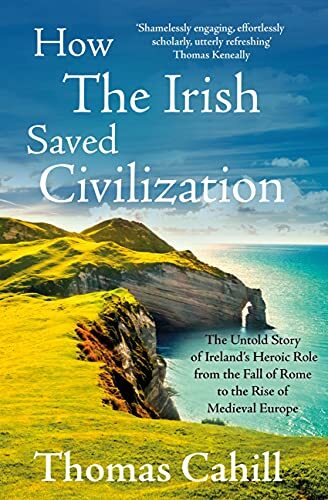Book Review: ‘How the Irish Saved Civilization’ by Thomas Cahill
How the Irish Saved Civilization by Thomas Cahill has the subtitle: ‘The Untold Story of Ireland’s Heroic Role from the Fall of Rome to the Rise of Medieval Europe.’
 Book Cover: ‘How the Irish Saved Civilization’
Book Cover: ‘How the Irish Saved Civilization’by Thomas Cahill
I loved the title of this book and was led to read it after I visited Tintagel; the Roman remains and exhibition at St Albans; and also the Roman Wall exhibition near Aldgate, London. My imagination was fired up and once again I longed to find out more about why exactly the Romans left Britain, how the Celtic and Roman Britons left behind felt about it, and about the very first entry of Christianity into Britain. So this book seemed to come along at just the right time for me.
I found the first part of the book exactly what I wanted: an exploration of what is known about the departure of the Romans from Britain, and about the fall of the Roman Empire. I was sad to realise that we have very little archival historical evidence at all of what happened in Britain through the 300s and the 400s. Only two writers fill that gap: St Patrick in Ireland, who lived from approx. 380 to 464, and wrote Confessio and Letter to Coroticus, and Gildas, a British monk who lived from 500 to 570, and wrote De Excidio et Conquesta Brittanniae.
I wondered: was this because Britain fell into complete illiteracy or they were too taken up with fighting off the Picts, the Scots and the Saxons? Or was it because all the manuscripts have been destroyed or lost over the centuries?
So this book filled in a huge gap for me. The author is very much on the side of the Irish and I did feel inspired by the life and work of St Patrick, especially as I feel a connection with him anyway – as I was born on St Patrick’s Day! St Patrick probably lived from approximately 380 to 464 though no dates are given on his manuscripts.
Within the Confessio (his spiritual autobiography) he gives a vivid account of his abduction into slavery in pagan Ireland at the age of 16, his time there and his escape back to Britain later on. Ultimately he chose to return to Ireland and begin his work there among the people he loved – even though some of them had enslaved him. He set in motion the inspiring work of the next few centuries, as the Irish took the lead in teaching Celtic people Christianity that would sit alongside the beloved Irish pagan stories, and thus find its way into their hearts.
They set up monasteries with monks and hermits, each in their little beehive cell. The monks recovered literacy and copied out ancient classical manuscripts lost and destroyed by the ravaging Germanic tribes, Ostrogoths and Visigoths etc, known to the Romans only as ‘barbarians,’ who sacked Rome and then overcame most of Europe: their first act seemingly to destroy libraries.
I have seen the exhibition on the Lindisfarne Gospel at Lindisfarne, and it is deeply moving. The work is exquisite: and this of course is just one of the few remaining manuscripts of such quality produced by Irish monks in numerous monasteries over the next few centuries. How much value and reverence we place on the surviving manuscripts now would be of great solace to those Irish monks, for their adversaries were ever keen to destroy libraries when they swept in and subdued the people of their conquered territories.
I found it very helpful indeed to clarify all the dates when it is believed certain key events happened, from the first invasion of Caesar and his troops into Britain in 43 BC onwards. Many dates are only conjectural of course but there is much scholarship to provide circumstantial evidence for the accuracy of these. It helps us become clear in our minds how Christianity first entered Britain, probably through the stories of Roman merchants and servants during the time of the Roman occupation.
Patrick was one of these Roman Britons who heard the stories and was entranced by them, hungering to learn more, gaining literacy and the ability to act upon his passion – thus began Celtic Christianity. St Augustine is so often held responsible for bringing Christianity to Britain (at the command of Pope Gregory, after which ‘the Roman system’ of Christianity was imposed). This is not true. Christianity was already in Britain long before he arrived in 597. The first evidence of Christianity in Roman Britain dates from the year 180. In fact, by the year 400, Christian worship had reached Ireland through interactions with Roman Britons. It’s St Patrick who is our true pioneer in that regard.
This book gave me a fascinating exploration of the Irish character and soul, and the story of the missionary monks from Ireland, moving into the West of Britain, into Scotland, into Europe, establishing monasteries, restoring literacy, creating their exquisite manuscripts. Many of the names of the Celtic saints who followed St Patrick – Columba, Aidan, Cuthbert, and of the monasteries the Irish monks set up in Britain and Europe – Iona, Durham, Ripon, Glastonbury, Amiens, St Gall, Reims, are names to conjure with, in any history of world renowned sacred places. As the author says,
Wherever they went, the Irish brought with them their books, many unseen in Europe for centuries… their love of learning and their skills in bookmaking… re-established literacy and breathed new life into the exhausted literary culture of Europe.
This is a truly inspiring and enlightening book.


Why not sign up now to my monthly newsletter which shares writing and publishing mews, and gems and snippets from my research discoveries. Plus you’ll be the first to know when I have a new book coming out.
And for those regular readers of my posts here who’d like to support me on my writing journey you can do so here on Buy Me a Coffee and I’d be very grateful.



